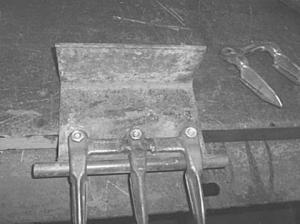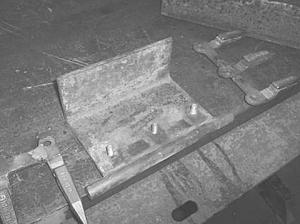How To Repair Broken Sickle Guards
Jim Taylor teaches advanced welding at Morrisville State College in Morrisville, New York. When one of his students came in with a 5-gal. pail full of broken combine sickle guards, the class decided to make a jig that would allow them to cut and weld the broken guards together.
"The student's dad had saved the broken guards and put them in a pail in his shop. After we rebuilt the guards he bolted them back onto his Deere soybean header. We made both two and three-section guards. He saved a lot of money because new triple guards sell for $45 apiece or more, and new double guards for at least $20," says Taylor.
The jig is made from an 8-in. length of 3/8-in. thick angle iron and has a length of 7/8-in. dia. round bar welded onto one edge of it. The rod is there to line everything up. They set the grooved side of an unbroken guard down over the bar, then drill a pair of holes in the jig and insert studs through them. They put a nut on each stud to keep the guard in place, then weld in new material on both sides of the broken guard. When they're done they unbolt the guards from the jig.
"It works good. In fact, the student said his dad has had better luck using the sickle guards we welded together than he did with new ones, because they weren't as likely to break," says Taylor. "The round bar has to be in precisely the right place in order to hold everything together correctly."
Contact: FARM SHOW Followup, Jim Taylor, P. O. Box 123, Bouckville, N.Y. 13310 (ph 315 527-8262; Taylorjd@Morrisville.edu).

Click here to download page story appeared in.
Click here to read entire issue
How To Repair Broken Sickle Guards MOWERS Mowers (31H) 32-2-38 Jim Taylor teaches advanced welding at Morrisville State College in Morrisville, New York. When one of his students came in with a 5-gal. pail full of broken combine sickle guards, the class decided to make a jig that would allow them to cut and weld the broken guards together.
"The student's dad had saved the broken guards and put them in a pail in his shop. After we rebuilt the guards he bolted them back onto his Deere soybean header. We made both two and three-section guards. He saved a lot of money because new triple guards sell for $45 apiece or more, and new double guards for at least $20," says Taylor.
The jig is made from an 8-in. length of 3/8-in. thick angle iron and has a length of 7/8-in. dia. round bar welded onto one edge of it. The rod is there to line everything up. They set the grooved side of an unbroken guard down over the bar, then drill a pair of holes in the jig and insert studs through them. They put a nut on each stud to keep the guard in place, then weld in new material on both sides of the broken guard. When they're done they unbolt the guards from the jig.
"It works good. In fact, the student said his dad has had better luck using the sickle guards we welded together than he did with new ones, because they weren't as likely to break," says Taylor. "The round bar has to be in precisely the right place in order to hold everything together correctly."
Contact: FARM SHOW Followup, Jim Taylor, P. O. Box 123, Bouckville, N.Y. 13310 (ph 315 527-8262; Taylorjd@Morris ville.edu).
To read the rest of this story, download this issue below or click
here to register with your account number.








